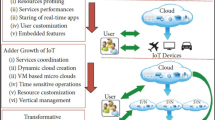Abstract
The data being produced by the devices connected to the Internet is ever growing. The large volume of data is also required to be processed and stored. Cloud computing provides data processing and storage services by using IT resources at gegraphically distributed locations. However, the cloud computing resources are usually far away from the sites where data is produced and processing is needed, which results in communication latencies that may not be acceptable for some appliations. This issue is addressed by Fog computing by brining data processing closer to the edge of the Internet. As fog infrastructures are significantly different from cloud in terms of scale, processing capacity, bandwidth etc.; more focused analysis is needed to explore avenues for performance improvement. In this paper, we analyze effects of resource distribution in small-scale fog computing infrastructure on its performance and resource utilization. We examine different topological arrangements of fog devices with varying resources. Our results show that the topological arrangement of fog nodes has a significant impact on the overall performance of fog computing infrastructure.


























Similar content being viewed by others
Data Availability
Parameters used to generate random data during this study are included in this published article.
Code Availability
Not applicable.
References
Dastjerdi, A. V., & Buyya, R. (2016). Fog computing: Helping the Internet of Things realize its potential. Computer, 49(8), 112–116. https://doi.org/10.1109/MC.2016.245
Naas, M. I., Boukhobza, J., Raipin Parvedy, P., Lemarchand, L. (2018) An extension to iFogSim to enable the design of data placement strategies. In 2018 IEEE 2nd International Conference on Fog and Edge Computing (ICFEC), Washington DC, pp. 1–8, https://doi.org/10.1109/CFEC.2018.8358724
Delfin, S., Sivasanker, N. P., Raj, N., Anand, A. (2019) Fog computing: A new era of cloud computing. In 2019 3rd International Conference on Computing Methodologies and Communication (ICCMC), Erode, India, pp. 1106–1111, https://doi.org/10.1109/ICCMC.2019.8819633
IEEE Standard for Adoption of Open Fog Reference Architecture for Fog Computing. IEEE. https://doi.org/10.1109/IEEESTD.2018.8423800
Nguyen, B. M., Thi Thanh Binh, H., The Anh, T., & Bao Son, D. (2019). Evolutionary algorithms to optimize task scheduling problem for the IoT based bag-of-tasks application in cloud-fog computing environment. Applied Sciences, 9(9), 1730. https://doi.org/10.3390/app9091730
Gupta, H., Dastjerdi, A. V., Ghosh, S. K., & Buyya, R. (2019). iFogSim: A toolkit for modeling and simulation of resource management techniques in Internet of Things, edge and fog computing environments. Preprint arXiv:1606.02007 [cs], Jun 2016. Retrieved December 10, 2019, from http://arxiv.org/abs/1606.02007
Ghobaei-Arani, M., Souri, A., & Rahmanian, A. A. (2020). Resource management approaches in fog computing: A comprehensive review. Journal of Grid Computing, 18(1), 1–42. https://doi.org/10.1007/s10723-019-09491-1
Jamil, B., Shojafar, M., Ahmed, I., Ullah, A., Munir, K., & Ijaz, H. (2020). A job scheduling algorithm for delay and performance optimization in fog computing. Concurrency Computation Practice Experience, 32, 7. https://doi.org/10.1002/cpe.5581
Mahmud, R., & Buyya, R. (2019). Modeling and simulation of fog and edge computing environments using iFogSim toolkit. In Fog and Edge Computing (chap 17). https://doi.org/10.1002/9781119525080.ch17
Mostafa, Ghobaei-Arani Alireza, Souri Fatemeh, Safara Monire, Norouzi (2020). An efficient task scheduling approach using moth‐flame optimization algorithm for cyber‐physical system applications in fog computing Abstract Transactions on Emerging Telecommunications Technologies 31(2). https://doi.org/10.1002/ett.v31.210.1002/ett.3770
Lindong Liu, Deyu Qi, Naqin Zhou, Yilin Wu (2018). A task scheduling algorithm based on classification mining in fog computing environment. Wireless Communications and Mobile Computing 20181-11. https://doi.org/10.1155/2018/210234848
Funding
Not applicable.
Author information
Authors and Affiliations
Corresponding authors
Ethics declarations
Conflict of interest
Not applicable.
Additional information
Publisher's Note
Springer Nature remains neutral with regard to jurisdictional claims in published maps and institutional affiliations.
Rights and permissions
Springer Nature or its licensor (e.g. a society or other partner) holds exclusive rights to this article under a publishing agreement with the author(s) or other rightsholder(s); author self-archiving of the accepted manuscript version of this article is solely governed by the terms of such publishing agreement and applicable law.
About this article
Cite this article
Jamil, S., Qureshi, R., Ahmed, S. et al. Impact of Resource Distribution on Performance of Fog Computing Infrastructure. Wireless Pers Commun 137, 1355–1374 (2024). https://doi.org/10.1007/s11277-024-11272-3
Accepted:
Published:
Issue Date:
DOI: https://doi.org/10.1007/s11277-024-11272-3




